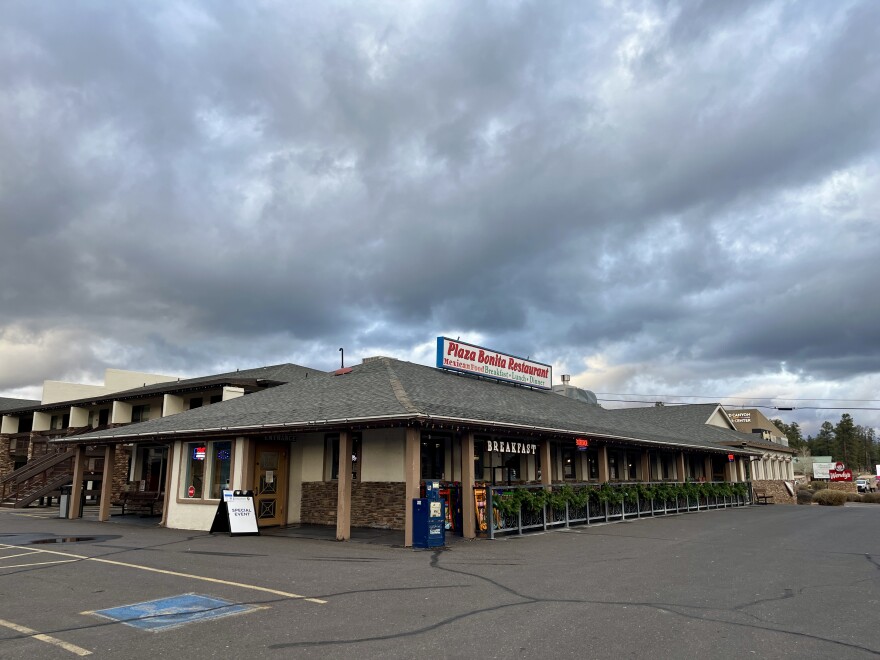An autumn drizzle blankets the ponderosa pine forests just south of Grand Canyon National Park.
But inside Tusayan’s Plaza Bonita restaurant, federal workers and their families are cast in a warm light as they chow down on fried chicken and tamales, chips and salsa.
The free meal, hosted by the Grand Canyon Conservancy, is a welcome change of pace for the federal workers, many of whom only returned to work earlier this month after the longest-ever government shutdown.
“This is one way for us to show our support when the community has really been suffering,” says Grand Canyon Conservancy CEO Elizabeth Silkes.
The conservancy is the non-profit partner of the park.
The events have taken place throughout November and are open to residents of Tusayan and Grand Canyon Village regardless of whether they’re federal employees.
“We actually had 250 people at the last dinner,” Silks says. “What it tells us is people didn't feel very valued who work in the park and the park communities. And a lot of this year has felt very personal.”
It’s been a challenging year for the employees at Grand Canyon National Park.
First came the Trump administration’s attempted mass layoffs last spring.
This summer, the Dragon Bravo Fire displaced park employees and concessionaires on the North Rim of the Grand Canyon and destroyed the historic Grand Canyon Lodge.
And then most federal workers missed two paychecks during the 43-day shutdown that ended on Nov. 12.
Most employees are expected to eventually receive their back pay, but the delayed wages had ripple effects throughout small gateway communities like Tusayan and Grand Canyon Village.
Plaza Bonita manager Javier Rosas says while tourists kept coming, they saw far fewer locals because of the furloughs.
“Normally here with us, Thursday was a locals day [when] all locals inside the park used to come to us, but now with this shutdown, there was no Thursday. So we saw a big difference with that,” says Rosas.
He says it's nice to see local families return during the conservancy’s hosted dinners.

Across the restaurant, Ashley Dickerson eats with a friend.
She works for the U.S. Department of the Interior at the Grand Canyon and says the impacts of the shutdown went well beyond the financial, affecting nearly every facet of her life.
“The impacts of stress on your mental health, on your physical health, on your relationships with family and friends as they're checking in and trying to figure out, ‘Are you going to be moving back home in a month because, you know, have they fired you yet?’ And I’m like, ‘I don't know what’s going on,'” Dickerson says.
About 40,000 employees with the Interior Department were furloughed nationally during the shutdown, which includes the National Park Service.
It’s unclear how many of Grand Canyon's nearly 500 employees were among them.
The families of federal employees also felt the shutdown’s weight.
Elijah and Wyatt Gibson, in eighth and sixth grade, respectively, eat with their mother. Their dad is on the park’s trail crew and was furloughed.
“He’s been spending a lot of days not going to work, and money’s been a little tight,” Elijah says.
Wyatt nods.
“Yeah, the big problem has just mostly been the money, and we’ve been having a lot of troubles with that,” he says.
The boys’ mother, Cassidy Gibson, says even as her husband receives back pay, their family hasn’t come out unscathed.
“We were able to tap into some savings, but we had to use more than we'd like, definitely more than we'd like. So it was hard. You know, that's our livelihood,” Cassidy Gibson says.
For other Grand Canyon workers, the shutdown complicated already stressful situations.
Kim Acker works for the Department of the Interior at the canyon and had an unexpected medical emergency days after the shutdown began.
“I essentially ended up with a large blood clot in my brain,” Acker says. “I’m looking at tens of thousands of dollars in medical bills, and it really made me think, can I afford to be missing paychecks if I'm going to have these bills that are due?”
Acker says it’s left her unsure of her future and whether federal employment is reliable.
She’s also concerned that another shutdown could be looming early next year, as the recent budget resolution only lasts until the end of January.
Acker says the Grand Canyon Conservancy’s events have helped her and others feel more valued, but it still doesn’t fully relieve her anxiety about what the future holds.
“In another month or two, are we going to be without paychecks again?” Acker says. “And to be literally told that we don’t matter, and we’re not important, and that we're low productivity, I mean, why would I want to work for something like that?”





